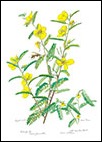
August 25
Partridge-pea
(Cassia fasciculata)
This native plant provides delicate fern-like foliage all summer. When the bright yellow flowers open in late summer they attract many flying insects. The most obvious is the Cloudless Sulphur butterfly that is the same color and size as the flowers. I knew I should include one in the painting. But when I put him in a big jar to paint his portrait, he wouldn’t sit still. He kept trying to fly through the glass. As I didn’t yet have the heart to sacrifice a little life for the sake of art, I let him go and, instead, painted the red wasp which is also always found on the plant. I had no qualms about killing a wasp.
Sometime later, I learned about John Abbot (1751-ca.1840), an English-born naturalist who arrived in Georgia in February, 1776 and spent more than sixty years studying and illustrating southeastern butterflies and other insects and the plants on which they were found. His collected specimens were displayed in major natural history collections of Europe. He also sold watercolor illustrations of the plants and insects.
When I saw Abbot’s illustration of Partridge-pea, I was so glad I had not put the Cloudless Sulphur in my painting—it would have looked like I had copied him. But how wonderful it is that, for at least two hundred years, that plant and that butterfly have worked and survived together. (We can assume that Abbot did kill his butterfly to paint it.)
I do, however, have the Cloudless Sulphur in this painting in a different way. As I was painting the Partridge-pea, I noticed a green caterpillar and a yellow one, each resembling the developing seedpods. I take it as my mission to report what I see so I put them both in my painting as I found them. Years later, in a lecture, I heard that the Cloudless Sulphur caterpillars are variable in color and habit—the yellow ones feed on flowers, the dark ones feed on stems. I could hardly wait to check my painting and see if that’s how I painted them. It is! There is no substitute for personal observation.
By the end of September it is time for me to strip the seed pods off the Partridge-pea (which may be four feet tall by then) and pull it up from my garden. It is an annual and won’t come back next year except by seed. The same is true for its little cousin in the painting, Cassia nictitans. Remaining in that open area of my landscape will be the perennial, Ageratum (Eupatorium coelestinum), illustrated in my painting dated September 24, which will continue to bloom another month or two.
The Cloudless Sulphur butterfly may be seen in my painting dated September 20, visiting Rudbeckia laciniata for nectar.
(Click on the picture for a larger image)
(Click here for the next painting)


